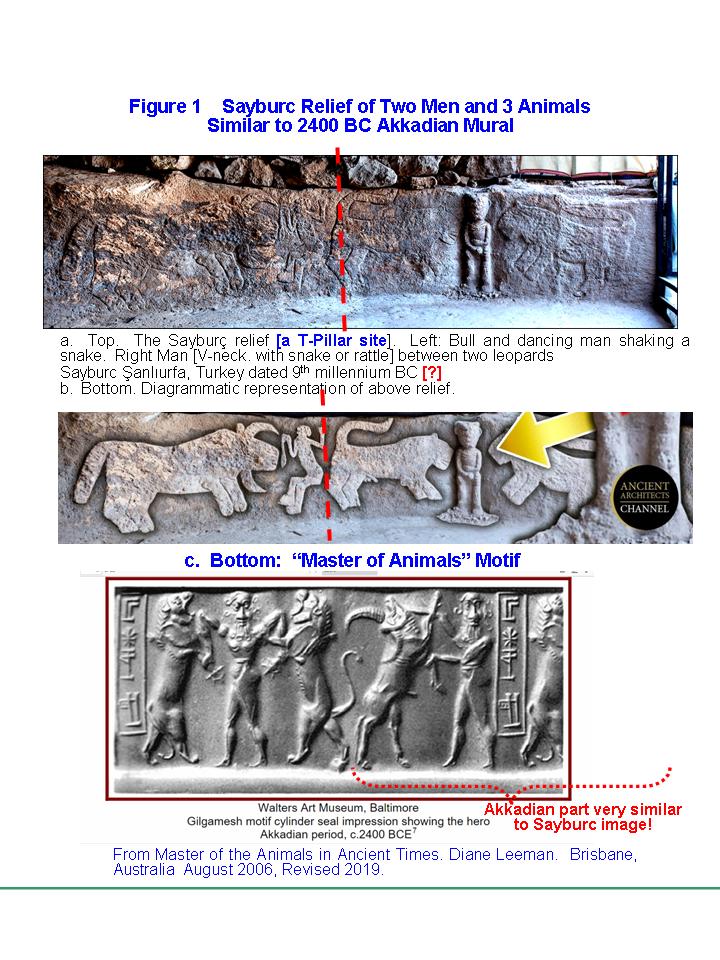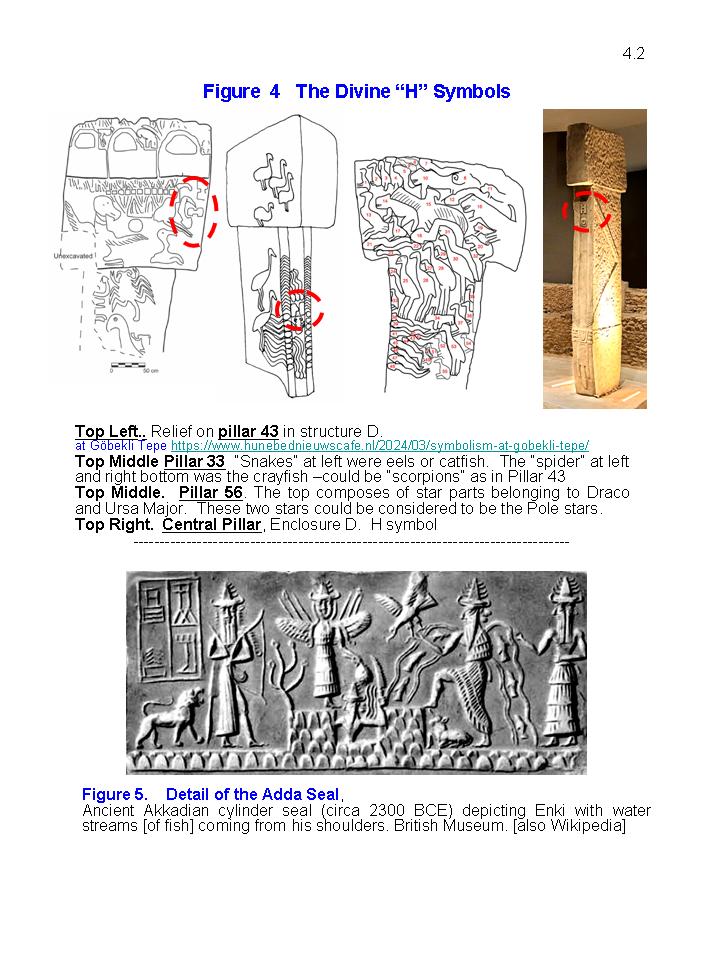
|
| 
|
GUI WORLD OF CULTURE |
WORLD OF FENG SHUI |
|
SUN TZU ART OF WAR |
on Feng Shui |
on Feng Shui |
|
|
|
Dr Ong Hean-Tatt September 2025 guiunicorn@gmail.com
There are animal and human motifs in the T-Pillars sites, like of Gobekli Tepe. There are much speculations about their meanings, but contradictions could have been resolved if there had been deeper references to the wider culture in Mesopotamia, especially of Sumerian and Hurrian cultures. The previous article especially showed that the Sayburc relief at Sanliufa about 17 km southwest of Gobekli Tepe depicts a man between two leopards (Figure 1). This is well known "Master of Animals" motif, common in the 4000 BC and after in Mesopotamian cultures. This Sayburc relief is very similar to an 2400 BC Akkadian wall mural. The previous article pointed out that this "man between two beasts" especially refers to Flood hero Gilgamesh. A number of Sumerian murals show Gilgameah with the bull and two lions. The identification of Gilgamesh in the Sayburc relief will facilitate interpretations of other motifs in the T-Pillars sites. In the Sayburc relief, the man in front of the bull would also be Gilgamesh. Enkidu, the male lover of Gilgamesh was also associated with the bull.

|
|
top
In the Sayburc relief, Gilgamesh was the male figure in front of the bull. The two lions would also be associated with Gilgamesh. Who was the naked male holding his penis? In Epic of Gilgamesh, Gilgamesh and Enkidu were helped by Enki, god of creation and fertility. Enki, god of creation and fertility, was associated with the penis
Once we realise this, we can decipher the other motifs in the T-Pillars sites! 
|
|
top
Figure 2 shows one of the central pillars at Gobekli Tepe, with the image of hands close at the navel. This image is similar to that of the Urfa Man at Sanliufa and also Karahan Tepe. These hands at the navel could also be hands at the penis (Figure 3). This was, of course, what is seen in the Sayburc relief. It was the image of the god Enki holding his penis! It is natural that the Gobekli Tepe motifs include the "H" which was rightly taken as the symbol of the "Divine" "supreme god". Wherever this "H" symbol is seen, it indicates the object was related to something divine. This "H" symbol was seen in Pillar 33 and 43 (Figure 4). Pillar 33 is interesting as it shows this "H" was associated with a river of fishes. This is a similar image of the 2300 BC Akkadian seal of Enki (Figure 5). There is no doubt that the images of Gobvekli Tepe's Pillars 43 and 33 were depicting a similar scene as the 2300 BC Akkadian seal of Enki god of creation and fertility. 
|
|
top
|
|
Check the ancient texts. Many self-styled "gurus" are ignorant of what the ancient texts say and contradict the texts.
|
|
Startling articles on SCIENTIFIC FENG SHUI & ASTROLOGY PHILOSOPHY:
Enrol in advance courses which include astonishing scientific and statistical evidence for Feng Shui and astrology! Current Feng Shui and astrology are essentially unscientific and out of date! |

|
DO NOT WASTE MONEY LEARNING CURRENT UNSCIENTIFIC OUT OF DATE FENG SHUI & ASTROLOGY! GUI MANAGEMENT CENTRE COURSES: Learn research oriented scientific Feng Shui and astrology. It is no longer a mystery what scientifically are qi and sha. Find out that ancient masters astonishingly knew of scientific nature of Yin Yang and 8 trigrams. Differences in landform affect which radiation energy is prevalent. Courses are backed by scientific research into ancient Mandarin Feng Shui texts like Green Satchels & Yang Yun Sun's texts like Han Lung Jing, Yi Lung Jing, Tian Yu Jing. |
|
GUI offers advance information rich courses backed by scientific, geography and astronomy research with reference to ancient Feng Shui texts. These fantastic Master courses are comprehensive and practical enough for you to do Feng Shui audits.
|
|
|
26 Jalan 20/14, 47500 Petaling Jaya, Selangor, Malaysia Tel: 603-56346361 56348915 Fax: 603-56347782 Website: http://www.guiculture.com email to guiunicorn@gmail.com File created: 24th August 2012, 24th February 2017 |
|